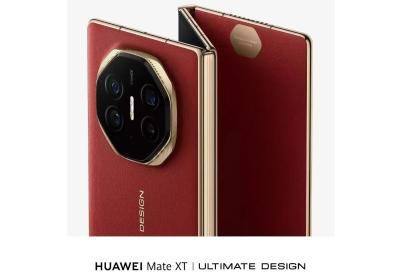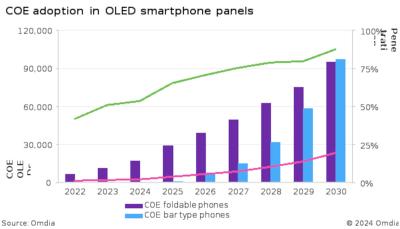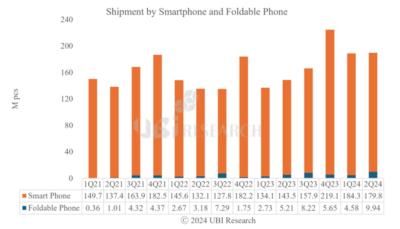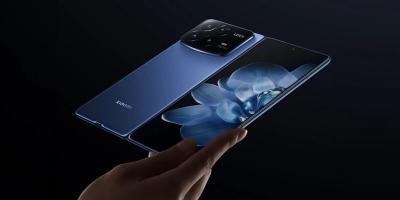Foldable OLEDs: introduction and market status
Foldable OLED displays can be bent by the user. These innovative displays enable new form factors, such as - such as phones that open into tablets, smart bands that open into smartphones and laptops with large displays. In 2019 the first foldable smartphones were launched, and after a rocky start, device markers are now introducing new devices to market as analysts expect increased adoption in the future.

Foldable smartphones
In 2019 Samsung finally introduced the first device, the Galaxy Fold - which had a problematic launch. Since then Samsung followed up with several new foldable phones, for example the Galaxy Z Fold 2 which sports an internal foldable display at 7.6" 1768x2208 HDR10+ 120Hz Dynamic AMOLED and also a larger 6.23" 816x2260 Super AMOLED cover display. Samsung also launched the clamshell-style Galaxy Z Flip.
Several companies offer foldable phones besides Samsung, including Motorola, Huawei and others. Huawei for example launched the Mate X2 in 2021, which features an inside-folding AMOLED display, a 8-inch 90Hz 2480 x 2200 one. There is also an external 6.45-inch 1160 x 2700 90Hz (240Hz touch sampling rate) AMOLED display.

Foldable OLED laptops
Foldable OLED laptops is another promising market segment. In 2021 Lenovo started shipping the $2,499 foldable ThinkPad X1 Fold laptop, with its 13.3" 2048x1536 foldable OLED display (produced by LG Display). Hopefully more companies will follow suit and we'll see more such devices on the market soon. In 2023, HP announced the Spectre Foldable PC, based on a 17" 2560x1920 foldable OLED display.

Samsung Display aims to increase its AMOLED production by 10% in 2025, hoping to sell more tablet displays and foldable displays
According to a report from Korea Samsung Display aims to increase its small-sized and mid-sized AMOLED panels production in 2025 by 10.25% compared to its 2024 production (or 475 million panels up from 432 million panels).
Of course SDC's production plans depend on market demand, but it seems as if the company believes the OLED market is set to grow or that the company aims to grab a larger share of the market. SDC mostly aims to increase production of IT panels (laptops and tablet displays) and foldable smartphone OLED panels.
Huawei officially launches its Mate XT tri-folding OLED smartphone
Huawei officially announces the world's first tri-folding OLED smartphone, the Mate XT. The phone and its specifications will be unveiled on September 10, and will ship on September 20.
Huawei allows people to reserve their Mate XT phone, and already over 1.25 million people reserved it.
Omdia forecasts fast growth in the adoption of COE technology for smartphone AMOLEDs, mainly foldable ones
Omdia says that Color-Filter on Encapsulation (COE) will grow to be the dominant technology in foldable OLED smartphone panels, and will replace the currently-used circular polarizers. COE adoption will grow at a 33% CAGR between 2024-2030, and by 2030 almost 90% of foldable smartphones will use COE technology, and almost 20% of all smartphone OLED panels.
The adoption of COE in OLEDs increases the panel effective brightness, which means that the display consumes less power compared to a polarizer OLED (same brightness) and also lasts longer. The color gamut is also improved. On the other hand, COE OLEDs suffer from higher reflectivity compared to polarizer OLEDs.
BOE, Tianma, TCL CSoT, EDO and Visionox all post improved quarterly earnings
Recently, BOE, Tianma, TCL, EDO and Visionox all posted their financial results for Q2 2024, and all were rather positive. Samsung Display and LG Display also posted increased earnings for the quarter.
So we start with BOE, that posted revenues of 93.4 billion yuan (13.17 billion USD) for the first half of 2024, an increase of 16.47% over H1 2023. Its net profit increased 210% compared to last year (2.285 billion Yuan, or $320 million USD). BOE enjoyed increased LCD sales and optimized production, and also noted high demand for high-end foldable OLED displays.
Tecno shows a tri-folding AMOLED smartphone concept
China-based smartphone maker Tecno has unveiled a new concept device, called the Phantom Ultimate 2, that sports a tri-folding OLED display.
The device is actually a working prototype, that when fully opened has a 10-inch 1620x2880 LTPO AMOLED display. When fully closed, the display is 6.48" in size. The company says it has developed a unique hinge design that enables the whole phone to be only 11 mm thick when fully closed. Tecno tested the device and the hinge and it lasts for over 300,000 folding cycles.
UBI Research: foldable OLED smartphone panel shipments reached 9.9 million in Q2 2024
UBI Research says that shipments of foldable OLED smartphone panels more than doubled in Q2 2024 (compared to the first quarter), reaching 9.94 million units. Foldable OLED smartphone panels accounted for 5.2% of the total OLED smartphone display market.
UBI expects foldable OLED panel shipments to continue growing in the second half of 2024, and sees total 2024 shipments exceeding 40 million. By 2028, the company expects foldable OLED panels to reach an almost 10% out of the entire OLED smartphone market.
DSCC: Almost 10 million foldable OLED panels shipped in Q2 2024, a new record high
DSCC says that shipments of foldable OLED panels reached a record high in the second quarter of 2024 at 9.8 million units - 126% higher than Q2 2023 (and 151% higher than the previous quarter). DSCC believes this will be the peak quarter in 2024, as the demand was fueled by the launch of Samsung's latest foldables, the Galaxy Z Flip 6 and Z Fold 6.
Samsung holds an almost 50% market share in foldable smartphone panels orders, followed by Huawei at 29%. Timing is relevant, as high demand follows new model shipping dates. DSCC estimates that clamshell devices have a 63% market share out of the total foldable smartphone market, with the rest taken up by in-folding devices.
Google launches three new smartphones, a foldable phone and a new smartwatch all powered by AMOLED displays
Google announced five new devices, all powered by AMOLED displays. We'll start with the Pixel 9 smartphone series, with the plain Pixel 9 offers a 6.3" 120Hz 2,700 nits (peak) 1080x2424 AMOLED display, a Google Tensor G4 chipset, 12GB of RAM and 256 GB of storage. The Pixel 9 Pro offers a 6.3" 3,000 nits (peak) 120Hz 1280x2856 LTPO AMOLED, and up to 16 GB of RAM and 1 TB of storage. The Pixel 9 Pro XL offers a similar but larger display - 6.8" 1344x2992 LTPO AMOLED.
Google's Pixel 9 Pro Fold smartphone is based on a 8" 120Hz 2,700 nits (peak) 2076x2152 foldable LTPO AMOLED display, and an external 6.3" 120Hz 1080x2424 AMOLED. The Pixel 9 Pro Fold is powered by a Google Tensor G4 chipset, and offers up to 16GB of RAM and up to 512GB of storage.
Huawei's Chairman is using a tri-folding smartphone, should we expect a launch soon?
Back in February we posted about rumors that suggest Huawei is planning to release the industry's first smartphone that sports a tri-foldable OLED display. When fully open, the device will sport a 10" display, which means it will double as a full tablet and a smartphone.
Now we have seen a photo of Huawei's Chairman that uses such a smartphone on a flight. This could mean that Huawei is getting ready to officially launch such a phone.
Xiaomi announced four new AMOLED devices, including two new foldable smartphones
Xiaomi announced four new devices, all with high-end AMOLED displays. First up we have the Mix Fold 4, a foldable smartphone that has a 7.98" 120Hz 3000 nits 2224x2488 foldable LTPO AMOLED display, and a second 6.56" 120Hz 3000 nits 1080x2520 LTPO external AMOLED display.
Xiaomi's Mix Flip is a clamshell smartphone that offers a 6.86" 120Hz 3000 nits 1224x2912 foldable LTPO AMOLED, with a secondary 4" 120Hz 3000 nits 1392x1204 AMOLED display.
Pagination
- Page 1
- Next page








